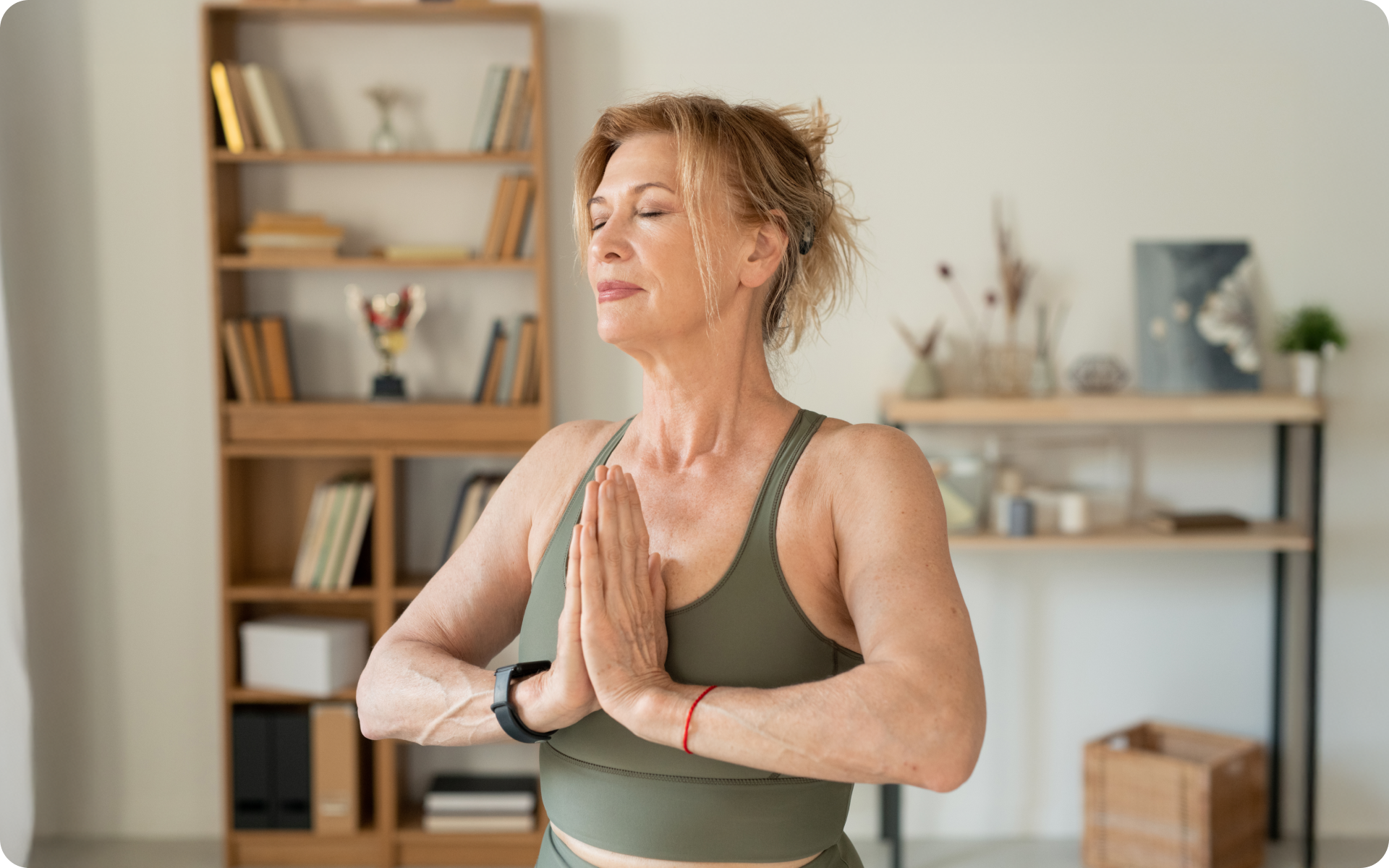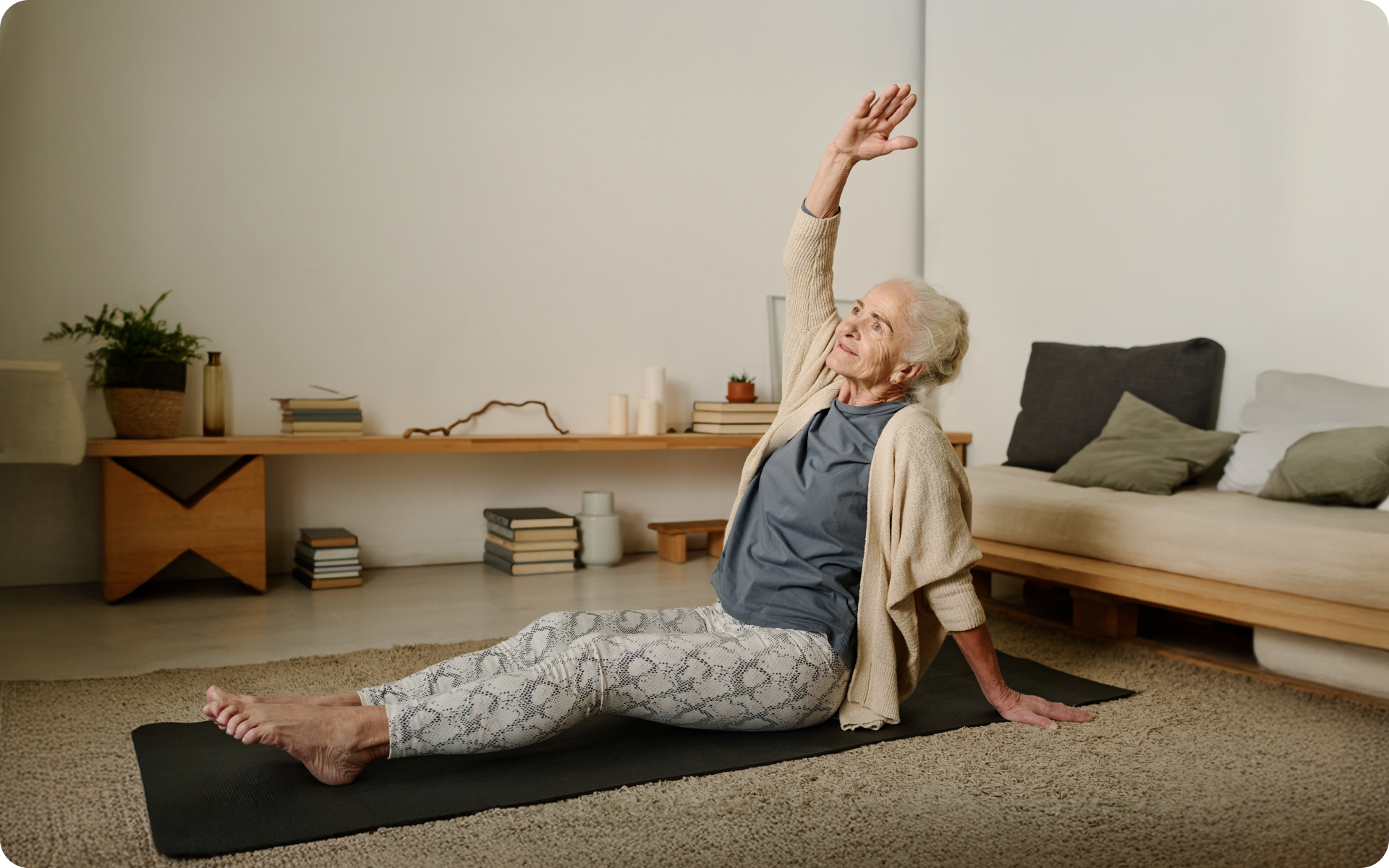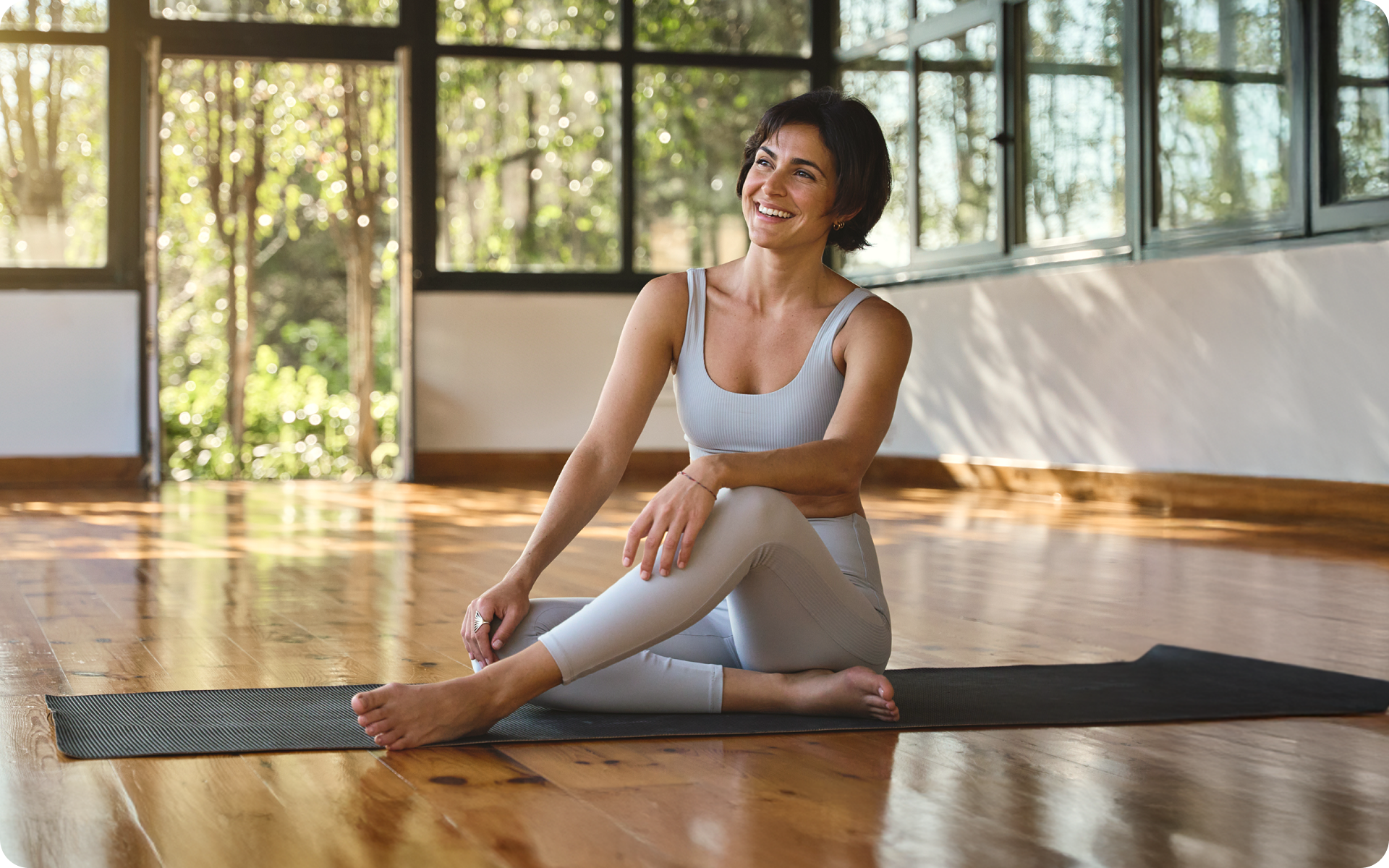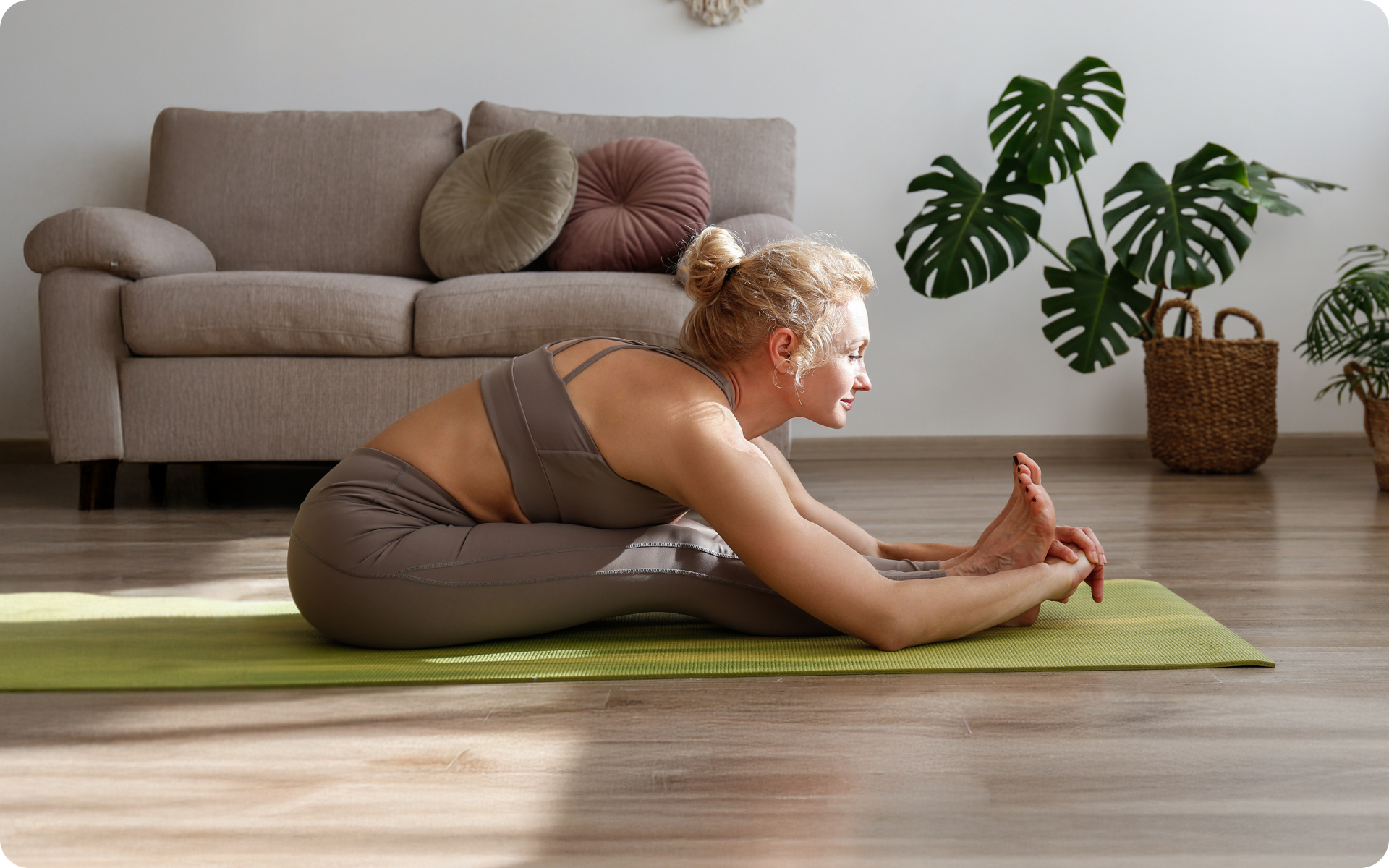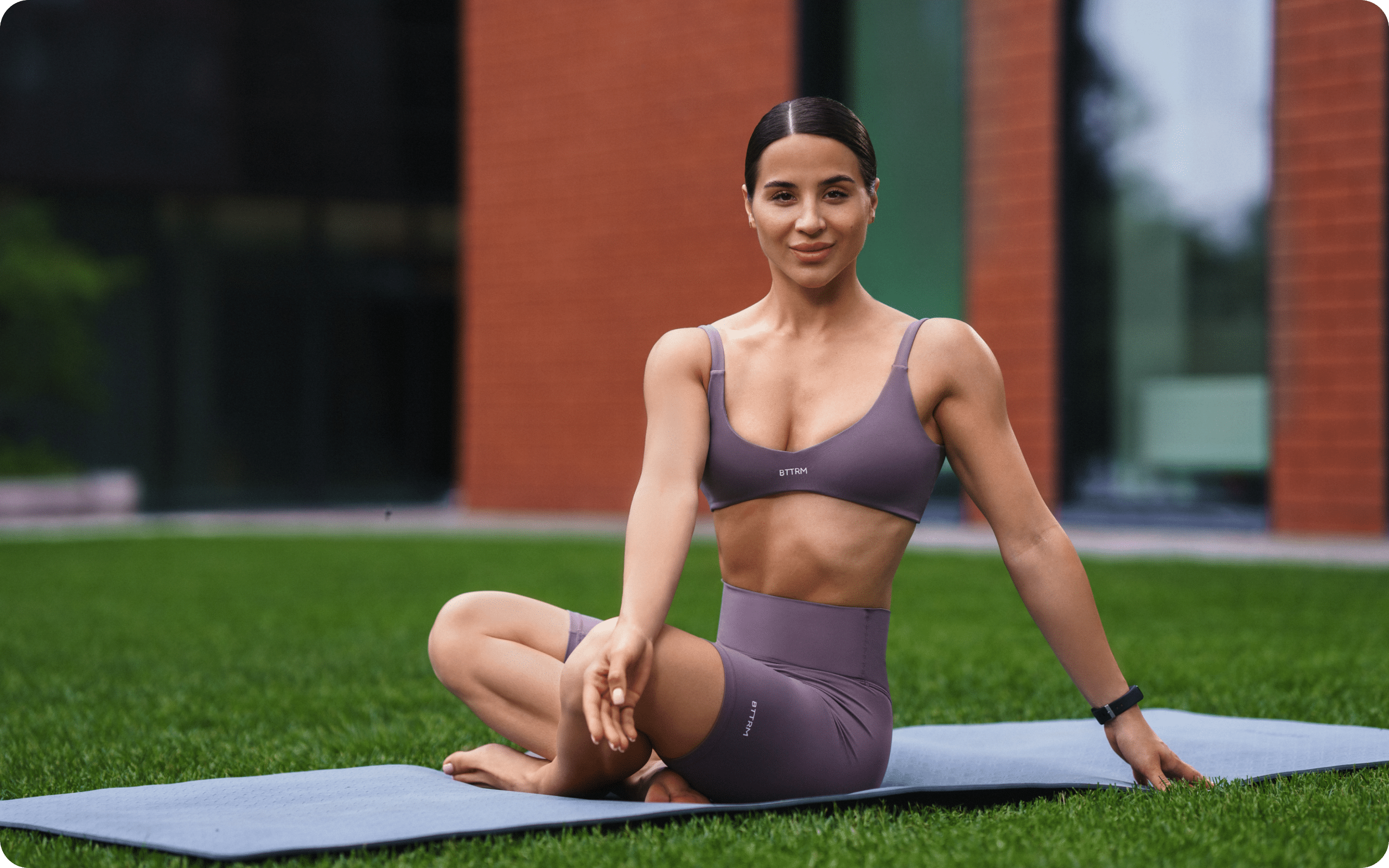Breath is a fundamental aspect of yoga, acting as a bridge between the mind and body, unifying them into a harmonious whole. In traditional yoga practices, breathing is not just a physical process, but a means to facilitate energy flow.
Even in dynamic forms like Vinyasa yoga, also known as ‘flow yoga’, breathing holds a significant role. It connects each posture with the next, creating a seamless, dance-like sequence. Its focus is on the fluidity of movements, rather than holding poses for long periods.
By aligning breath with movement, you can view Vinyasa yoga as a manifestation of the interconnectedness and constant flow of life.
Here’s a guide to some common Vinyasa poses and everything else you need to know to get started. Beyond the poses, you’ll discover a practice that can calm the mind, enhance flexibility, and promote strength.
What Are Vinyasa Yoga Poses?
Vinyasa yoga poses are a series of postures that are linked together in a continuous flow, guided by the breath. It’s an active form of yoga and is often described as a moving meditation.
There is no set sequence or structure for vinyasa yoga poses, unlike other types of yoga like Ashtanga or Bikram. This allows for creativity and variety in each class, the instructor may design a sequence to suit the needs and energy of the students.
The transitions between poses in Vinyasa are just as important as the poses themselves. The smooth flow from one pose to another creates a sense of fluidity, grace, and rhythm.
Dropping pounds by the dozens without putting yourself through the wringer is everyone’s weight loss pipe dream. But what if we told you that the BetterMe app can make that happen? Keep yourself in prime shape with our fat-blasting workouts, delicious budget-sparing recipes, and body-transforming challenges with our app!
Vinyasa yoga is a style of yoga that links breath and movement, typically starting with Sun Salutations and moving to a sequence of postures. Here are some common poses you might encounter in a Vinyasa yoga class:
- Mountain Pose (Tadasana): This pose is often used as the starting position for all the standing poses. It’s great for improving posture and balance.
- Downward-Facing Dog (Adho Mukha Svanasana): A fundamental pose in many styles of yoga, this inverted V-shape pose helps to stretch the entire body.
- Warrior I and II (Virabhadrasana I and II): These powerful standing poses help to build strength in the legs and core, while also stretching the hips and groin.
- Triangle Pose (Trikonasana): This pose stretches the legs, groins, and hips, opens the chest and shoulders, and helps to relieve lower back pain.
- Tree Pose (Vrikshasana): This balancing pose helps to improve focus, concentration, and stability. It also stretches the thighs, groins, shoulders, and chest.
- Crow Pose (Bakasana): An arm balance pose that requires strength, coordination, and balance. It strengthens the arms, wrists, and abdominal muscles.
- Upward-Facing Dog (Urdhva Mukha Svanasana): This pose strengthens the arms and wrists, tones the abdomen, and stretches the chest and opens up the lungs.
- Child’s Pose (Balasana): A restorative pose, often used as a resting position in between more difficult poses during a Vinyasa flow.
- Three-Legged Downward-Facing Dog (Tri Pada Adho Mukha Svanasana): This pose is a variation of Downward-Facing Dog that helps to stretch and strengthen the whole body.
- Pigeon Pose (Eka Pada Rajakapotasana): This pose is a deep hip opener, stretching the thighs, groin, psoas, abdomen, chest, shoulders, and neck.
- Chaturanga Dandasana: Also known as Four-Limbed Staff Pose, it strengthens the arms and wrists and tones the abdomen.
- Savasana: Also known as Corpse Pose, this is a restful concluding pose where yogis lie on their backs with their arms and legs spread out. It promotes deep relaxation and a sense of calmness.
Each Vinyasa flow can be different depending on the teacher’s style and the level of the class, so these poses might not always be included in every class.
Here’s an example of a Vinyasa flow sequence:
Begin your Vinyasa flow with a Sun Salutation. Starting from a standing position in Mountain Pose (Tadasana), inhale deeply as you raise your arms overhead, palms facing each other. As you exhale, fold forward, hinging at your hips into a forward bend.
Next, with an inhale, step or lightly hop your feet back to a high plank position, preparing for Chaturanga Dandasana. Exhale as you lower your body to the floor, keeping your elbows tucked in close to your body. Transitions are important; inhale synchrony with each movement.
As you inhale, press your palms into the mat, straighten your arms, and lift your torso up, transitioning into Upward-Facing Dog (Urdhva Mukha Svanasana). Exhale, and lift your hips high, moving your body into an inverted V shape for the Downward-Facing Dog (Adho Mukha Svanasana).
Next, inhale and step your right foot forward between your hands, coming into Warrior I (Virabhadrasana I). Exhale, and open your hips and torso to the left, transitioning into Warrior II (Virabhadrasana II).
From here, on your next exhale, straighten your right leg and reach your right hand to your right shin or ankle for Triangle Pose (Trikonasana). Inhale, and return to standing, then exhale as you shift your weight to your right foot and bring your left foot to your right inner thigh or calf for Tree Pose (Vrikshasana).
Inhale as you return to stand, then exhale and bend forward, planting your hands on the mat and hopping your feet back to Crow Pose (Bakasana). This pose requires strength and balance, so take your time to find stability.
Inhale, hop back to your feet and come to a kneeling position for Child’s Pose (Balasana). This is your time to rest and check-in with your body. After a few rounds of breath, lift your right leg high for Three-Legged Downward-Facing Dog (Tri Pada Adho Mukha Svanasana) on an inhale.
Exhale, and bring your right knee towards your right wrist, setting up for Pigeon Pose (Eka Pada Rajakapotasana). Spend a few breaths here, allowing your hips to relax and open.
Finally, return to Downward-Facing Dog to transition to Savasana. Lie on your back, allowing your body to relax completely as you focus on your breath, bringing the Vinyasa sequence to a close.
Remember, every Vinyasa class can be different. Use this sequence as a guide, but always listen to your body, adjusting poses and transitions as necessary. All movements should be synchronized with your breath, emphasizing the flow of energy through your body.
Read more: Yoga for Moms Who Need a Break: A Simple Guide
Why Is Breath So Important in Vinyasa Yoga?
Breath is integral to the practice of Vinyasa yoga, as it serves as a guide for movement and helps create a sense of fluidity throughout the sequence. As we flow from one pose to another, our breath acts as an anchor, keeping us present and focused on each movement.
Deep diaphragmatic breathing also increases oxygen intake and helps to release tension and stress (1). This can be especially beneficial in a fast-paced Vinyasa class, where we may feel the need to rush or push ourselves too hard. Focusing on our breath can help us slow down and listen to our bodies, preventing injury and promoting mindfulness (4).
Moreover, coordinating movements with breath helps to create a meditative state, quieting the mind and allowing us to be fully present in the practice. By synchronizing breath with movement, we can cultivate a sense of awareness and connection between the mind, body, and spirit.
In our blog titled Restorative Yoga Poses, we discuss in more detail how breath can enhance our yoga practice and promote relaxation.
Is Vinyasa The Hardest Yoga?
Some may find Vinyasa yoga harder than other types because it lacks a set sequence. Each class and teacher may have a different focus, making it challenging to know what to expect. Beginners especially may find it difficult to keep up with the pace and transitions of a Vinyasa flow.
However, the flexibility of this practice allows instructors to choose whether to have a set sequence or not, to ease new students into the practice.
On a physical level, Vinyasa yoga isn’t as demanding as other types such as Bikram which tests endurance in a heated room. Or Ashtanga which is a set sequence of poses that are increasingly challenging.
Ultimately, the difficulty level of Vinyasa yoga depends on the individual and their experience with the practice. With consistent practice, anyone can find their flow in this dynamic style of yoga.Our advanced chair yoga poses article has workouts tailored for a tight schedule.
Is Vinyasa Harder Than Hatha?
Both Vinyasa and Hatha yoga have their own unique challenges, so it is difficult to say which one is harder. While Vinyasa involves flowing movements and quick transitions between poses, Hatha focuses on holding poses for longer periods of time.
For some, the fast-paced nature of Vinyasa may make it more physically demanding, while others may find the stillness and deep stretching of Hatha more challenging.
It all comes down to your physical abilities and personal preferences. Both Vinyasa and Hatha can provide a fulfilling and rewarding experience.
Want to build an attention-grabbing bubble butt, blast away fat that’s stored in all the wrong places, spring-clean your diet, turn back the clock on your skin, skyrocket your self-confidence and shatter your insecurities? Check out the BetterMe app and set this plan in motion!
What Are The Cons of Vinyasa Yoga?
The cons of Vinyasa yoga are; that it can be physically demanding, that it may not suit everyone’s preferences, and that it requires a certain level of physical fitness. There is also the risk of injury if poses are not performed correctly.
Additionally, Vinyasa yoga may not be suitable for those looking for a more spiritual or meditative practice. While it does incorporate elements of mindfulness and breathwork, it may not have the same level of focus on these aspects as other forms of yoga, such as Hatha or Yin.
Lastly, some people may find the fast-paced nature and constant movement in a Vinyasa class to be overwhelming or stressful. It’s advisable to modify poses as needed to prevent burnout or exhaustion during practice.
Read more: Somatic Yoga: A Journey to Self Discovery
Do You Lose Weight With Vinyasa Yoga?
Vinyasa yoga may increase your heart rate and burn calories since it’s a dynamic and physically demanding practice (5). However, total calorie expenditure is heavily influenced by diet and other lifestyle factors, not solely reliant on this yoga practice.
Beyond how many calories you burn, Vinyasa yoga can also help with weight loss by:
- Building muscle: As you flow through different poses, you engage various muscles, which can help to maintain and strengthen them (3).
- Reducing stress: Vinyasa yoga incorporates breathwork and mindful movement, both of which can help to reduce stress levels. Lower stress levels may lead to better eating habits and improved digestion (2).
- Improving sleep: A consistent Vinyasa yoga practice can help you get better sleep, which is essential for maintaining a healthy weight (2).
- Promoting mindfulness: By focusing on your breath and being fully present in the moment, Vinyasa yoga can help you become more aware of your body’s needs and make healthier choices (2).
Practising yoga alongside other weight loss strategies such as a healthy diet and regular exercise can help you achieve your weight loss goals safely and sustainably.
Our Beach Yoga Guide has tips for making the most of your practice while enjoying the beautiful outdoors.
FAQs
How Many Times a Week Should I Do Vinyasa Yoga?
You should do Vinyasa yoga as many times a week as your body and schedule will allow. Some may prefer to do it daily, while others may find two to three times a week sufficient.
What’s more important than frequency is consistency. Doing Vinyasa yoga regularly, even if it’s just once a week, can help you progress in your practice and reap the benefits over time.
Is Vinyasa Yoga Better Than Pilates?
Both Vinyasa yoga and Pilates have their own unique benefits, so it’s difficult to say which one is better. While Vinyasa focuses on flowing movements and breathwork, Pilates centers around core strength and stability.
If your goal is to improve flexibility and mindfulness, Vinyasa may be a better fit. If you’re looking to strengthen your core and improve posture, Pilates may be more suitable.
Do You Lose Weight With Vinyasa Yoga?
You may lose weight with Vinyasa yoga if you practice it along with other healthy habits like a balanced diet and regular exercise (5). However, the primary purpose of yoga is not weight loss, but rather to promote overall well-being and mind-body connection.
Can Vinyasa Tone Your Body?
Vinyasa yoga practice alone won’t have a significant fat-burning effect that’s necessary for a toned body. Depending on how much body fat you’re carrying, you may need intense, cardio-based exercises to see more defined muscles.
You may include Vinyasa yoga in a comprehensive fitness routine to improve overall muscle tone and strength. However, it should not be the sole form of exercise for achieving a toned body.
The Bottom Line
Vinyasa yoga poses offer a dynamic and engaging form of exercise that can build strength, improve flexibility, reduce stress, and promote mindfulness. While weight loss may be a secondary benefit of Vinyasa yoga, it’s not its primary purpose. Consistency in practice, along with a healthy lifestyle, can lead to a balanced and fulfilling mind-body connection.
DISCLAIMER:
This article is intended for general informational purposes only and does not serve to address individual circumstances. It is not a substitute for professional advice or help and should not be relied on for making any kind of decision-making. Any action taken as a direct or indirect result of the information in this article is entirely at your own risk and is your sole responsibility.
BetterMe, its content staff, and its medical advisors accept no responsibility for inaccuracies, errors, misstatements, inconsistencies, or omissions and specifically disclaim any liability, loss or risk, personal, professional or otherwise, which may be incurred as a consequence, directly or indirectly, of the use and/or application of any content.
You should always seek the advice of your physician or other qualified health provider with any questions you may have regarding a medical condition or your specific situation. Never disregard professional medical advice or delay seeking it because of BetterMe content. If you suspect or think you may have a medical emergency, call your doctor.
SOURCES:
- Effects of Diaphragmatic Breathing on Health: A Narrative Review (2020,nih.gov)
- Exploring the therapeutic effects of yoga and its ability to increase quality of life (2011,nih.gov)
- Harnessing the benefits of yoga for myositis, muscle dystrophies, and other musculoskeletal disorders (2022,nih.gov)
- Sports Performance and Breathing Rate: What Is the Connection? A Narrative Review on Breathing Strategies (2023,nih.gov)
- Study Sees Beneficial Role of Yoga in Weight-Loss Program for Adults With Obesity or Overweight (2021,nih.gov)





